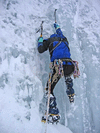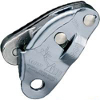The GRIGRI 2 belay device with assisted braking is designed to facilitate belay maneuvers. The GRIGRI 2 works equally well for lead climbing and top roping. It may be used on all single dynamic 8.9 to 11 mm ropes on the market (ideal at 9.4 mm to 10.3 mm). Both compact and ultra-light, the GRIGRI 2 will accompany you on climbs around the world for many years. The GRIGRI 2 has a new design that allows excellent control during the descent.
In rock climbing, mountaineering and other climbing disciplines, climbers give a climbing grade to a route that concisely describes the difficulty and danger of climbing the route. Different aspects of climbing each have their own grading system, and many different nationalities developed their own, distinctive grading systems. There are a number of factors that contribute to the difficulty of a climb including the technical difficulty of the moves, the strength and stamina required, the level of commitment, and the difficulty of protecting the climber. Different grading systems consider these factors in different ways, so no two grading systems have an exact one-to-one correspondence.
Twenty mountaineering associations met in Chamonix, France in August 1932 for an alpine congress. They decided to found an international federation which would be in charge of the “study and solution of all problems regarding mountaineering”. No small task one would say. One of those problems was the lack of a universal climbing grade system, which was finally resolved with the creation of the UIAA climbing grade 40 years later. Count Charles Egmond d’Arcis from Switzerland became the first president and he gave the new federation the name UIAA – Union Internationale des Association d’Alpinisme.
Recent accidents alerted us to the probability of weakened anchors on routes equipped in tropical, marine environments.
These anchors have been weakened by corrosion accelerated by the proximity of the sea and year-long, warm, wet climates. First samplings from some climbing areas in tropical marine environments showed that 10 to 20% of anchors could have a resistance as low as 1 kN to 5 kN (cf. Nominal climbing falls load anchors with forces of 1 kN to 5 kN; a 25 kN minimum bolt strength is required by the standards)!!
You've got experience climbing various routes and it's now the time to open your first route. If you fancy placing your own gear; that is nuts, friends etc, then you should aware that bolts are not always the superb protection if not placed properly.
Having said that, recently I read an article on a blog where a guy from Australia died after having a faul on a sandstone route. You can read the initial post at http://upskillclimbing.blogspot.com/2009/02/how-to-bolt-rock-climbs-and-how-not-to.html
The real art of mountaineering is the art of surviving. The more difficult surviving becomes, the greater the art of mountaineering becomes. And this will always happen whenever you have to go one more step forwards. Where nobody has ever been, where it's difficult for anyone to follow.
'R.Messner'




Latest forum topics
(Posted on: 11/02/2017 by Vincent)
(Posted on: 29/01/2017 by John87)
(Posted on: 29/01/2017 by Guest)
(Posted on: 29/01/2017 by John87)
(Posted on: 20/09/2016 by sardiman)



